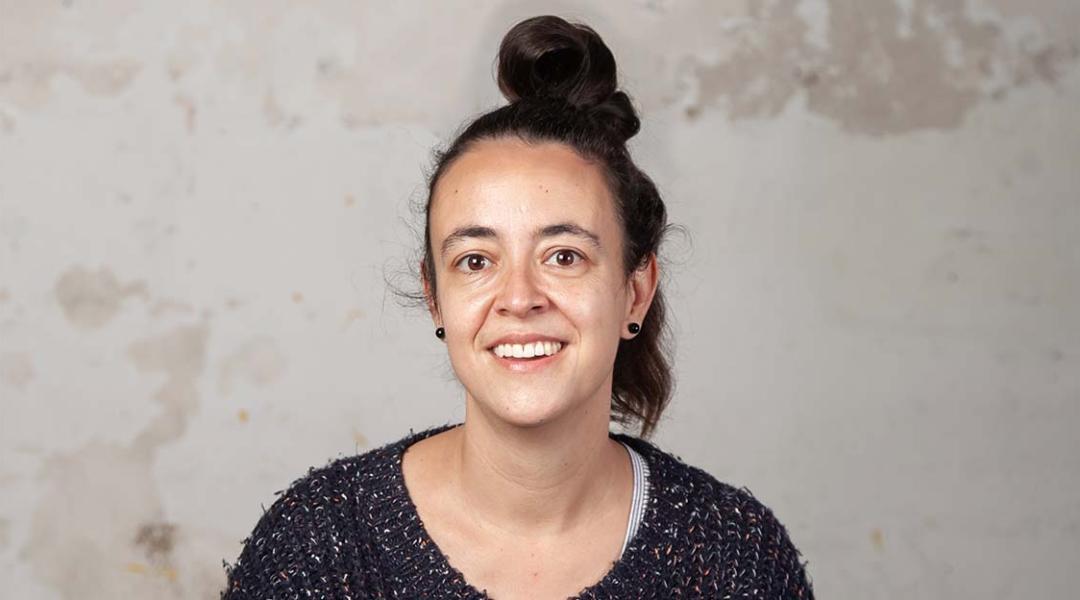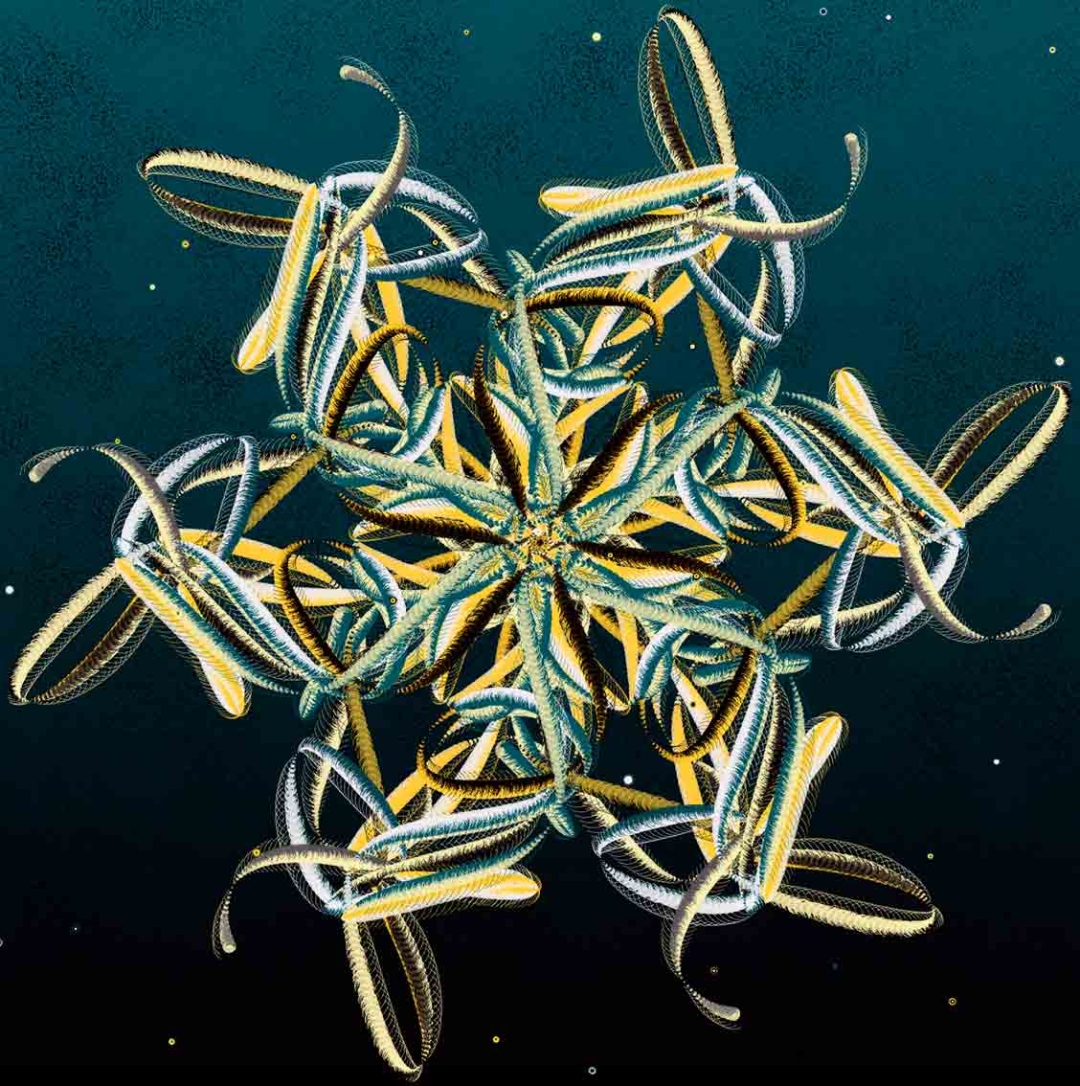Anna Carreras
Boundless

How do you build something that doesn’t exist but that, nevertheless, has grown as an idea of the mind? How do you shape creativity? These are two of the questions that Anna Carreras, engineer and digital artist, invites us to reflect on regarding generative art in general and her work in particular. We see her during her participation at ISEA2022, one of the most important digital art events of the year, and chat to her about generative art, creative language, and the infinite range of opportunities that the Internet offers the world of art.
Anna Carreras (Barcelona, 1979) combines her studies in Engineering and Fine Arts —two disciplines that may seem opposites— to create works of art that know no physical or creative boundaries. Her digital creations are unique and unrepeatable, not only in their conception, but also literally, since they’re generated based on an algorithm that never repeats a single pattern or idea. New online galleries and the growingly familiar metaverse give generative art wings, which first emerged in the 1960s but is living its golden age right now. Anna is one of the most well-renowned digital artists on the international scene, whose inspiration comes from her grandmother’s crochet, her habits, and the landscapes of her surroundings. Her infinite talent and imagination do the rest.
How is a digital artist born? Where does this interest come from?
My interest comes from exploring the digital medium as a space and language for artistic creation. A contemporary medium in which we move, work, and connect more and more in our day-to-day lives. Approaching artistic creation using modern tools and languages that are with us and shape our everyday lives.
You wanted to study Fine Arts but, in the end, you chose Telecommunications Engineering. Is digital art a mixture of both disciplines?
Totally, it’s a balance between both. They say a leopard never changes its spots; creating art is my passion, I love it and enjoy it, so I finally found my way back, incidentally, to doing what I love. Everything I learnt while studying engineering has served as the base to explore the medium and create, for example, an interactive piece with sensors and electronics or images that are generated based on a programmed algorithm. I’ve complemented that technological baggage with design and art knowledge over the years, and every day on the job, by polishing shades and creating colour palettes and textures.
“The pandemic has taught us the value of culture for humans, how we need it to feel good, fulfilled, happy”
Tell us what generative art is and why it’s currently so relevant.
Generative art creates abstract visual art based on algorithms. We don’t use the computer as a tool to draw, but rather ask it to enlarge, change, evolve, and generate the images we see in its own language. It’s like making yourself geometric paintbrushes in unique colours to paint with. The pandemic has taught us the value of culture for humans, how we need it to feel good, fulfilled, happy. We learnt that art can also be enjoyed online. And generative art, which creates images following the aesthetic the artist has suggested, but which always change slightly, making them unique and unrepeatable, fits in perfectly with this growing appreciation for digital art and that online enjoyment of it.
Also, you’ve focused your work on using generative algorithms, creative code, and interactive technology as a means of communication and a way of generating experiences.
I use algorithms and programming languages to create art. I don’t seek a particular goal or functionality, rather exploring abstract shapes and colours that convey emotions and transport us to other places, other landscapes, other memories. It’s a different way of using technology.

‘Ganxillo’ is one of the works of this Catalan artist, created as a tribute to her grandmother. © Anna Carreras - Ganxillo 2021 Feral FIle
You also create interactive installations, which is the goal of getting the public to collaborate and participate in your works?
Interactive installations, where the public participates and contributes to creating the work, allow us to explore unexpected and surprising results, even richer and more diverse that what I can initially plan. Furthermore, allowing the public to participate in the work, to touch it and change it, explore it, and play with it, also helps to remove that aura of grandeur that the art world has and bring it down to the earth of our day-to-day lives.
Inspiration is a key element for any creator; where does a digital artist’s inspiration come from?
It comes from my surroundings, my landscape, and my habits. From the Mediterranean and also the dry lands of Aragón, full of olive groves and almond trees. For example, I have a piece called Ganxillo, with ‘x’ like my grandmother used to say crochet, which is a tribute to all those hours of winter conversations spent crocheting and creating with our hands, stitch by stitch, chat by chat. Also, the colours of the Mediterranean have inspired Trossets, which collects pieces of what surrounds me to reinterpret them in a geometric and colourful fashion, an overview of the environment and the landscape.
“Allowing the public to participate in the work, to touch it and change it, explore it and play with it, helps to remove that aura of grandeur that the art world has”
Casey Reas, a famous American artist, got in touch with you through Twitter. What was that like?
Casey Reas is an artist I’ve been following for years and, also, he’s the creator of the programming language I use to create my art. His contacting me was incredible, I couldn’t believe it. He wanted to collaborate on several projects and encouraged me to take part in a collective exhibition of generative art. Working with him has been incredibly rewarding and his suggestions have helped me to believe in my work, they’ve boosted my professional career as an artist.
One of your most well-known projects, Trossets, sold 1,000 copies in less than 45 minutes on Internet galleries, is the future of art online?
Throughout my career, which began 17 years ago, online galleries have helped me reach a wider audience, allowed more people to discover me, and sent more projects, exhibitions, and collaborations my way. The consumption of art and culture on the Internet and the metaverse is here to stay, it allows us to reach most remote places in the world.
Additionally, this year you’re participating in ISEA2022, one of the most important events for digital art, will we see your work there?
We’ll see several pieces from 2021 and a few new ones from 2022. A journey through the landscapes that inspire me and that I love to share with the entire world.
Do you believe that talent is essential in the world of art? Do you work on it every day?
I think hard work is essential, slowly, step by step. You work on technique and creativity, and improve on them by creating, by practicing. That romantic idea of the artist that’s struck by inspiration and is so talented that they capture that idea in a fit of madness isn’t me. I’ve spent lots of years working, insisting, improving, and growing.
“That romantic idea of the artist that’s struck by inspiration and is so talented that they capture that idea in a fit of madness isn’t me. I’ve spent lots of years working, insisting, and improving”
Would you say that every day is the first day in digital art, because it’s a discipline that’s constantly evolving and requires continuous training?
It’s true that it’s constantly evolving and requires continuous training. However, digital art and, specifically, generative art, have a long trajectory within the world of art. The pioneers in generative art are from the 1960s —like Vera Molnar, Frieder Nake, Georg Nees, Charles Csuri…— and they appear because of the new Avant-garde and contemporary movements of the 20th century and abstract and contemporary art. There’s a long road and baggage that supports current artists.
You’ve exhibited in Barcelona, Madrid, Liverpool, San Francisco… Does digital art need to travel beyond digital borders?
Yes, physical experiences to enjoy art have their own ambiance. They add value to enjoyment and being able to appreciate it collectively allows us to share it and experience it differently. So, yes, combining digital art online with exhibitions, some pieces hung on a wall, or a cultural event brings us even closer to enjoying it and experiencing it fully.




